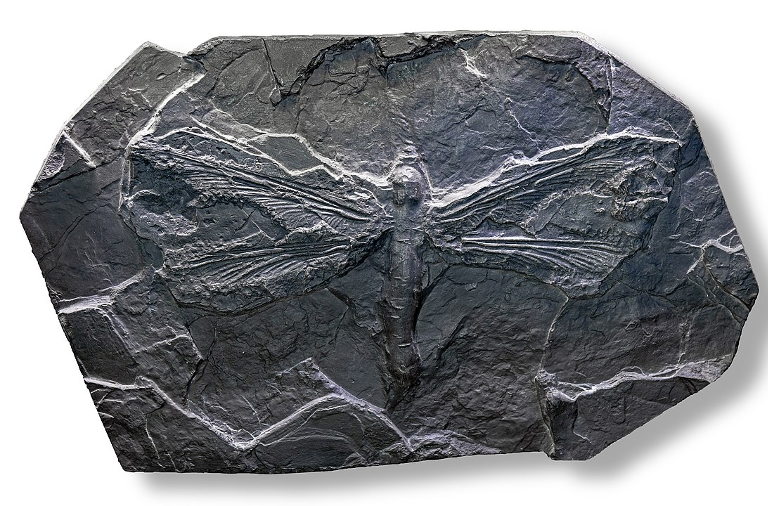The Carboniferous Rainforest Collapse…
305 million years ago, the Earth was a jungle planet. Swampy rainforests stretched across the earth, contiguous across a vast supercontinent called Laurasia. The world of the late Carboniferous era, as this period is known, was warm and humid. Its water-logged forests home to giant insects and amphibians; while our early synapsid ancestors were still small and lizard-like. This ecosystem functioned differently than our contemporary jungles, fallen trees were often preserved as they sank into deep, anoxic swamps — rather than decaying on the surface. The preserved trees would eventually fossilize, their carbon-rich remains becoming the coal deposits that give this era its name. These vast coal forests dominated Earth for millions of years. And then in the blink of a geological eye, this entire ecosystem disappeared.
The exact causes of this event, called the Carboniferous rainforest collapse, are not fully known. Many changes are observed in the geological record around this time, but whether they were the results or causes of the collapse is difficult to ascertain. Ice sheets were spreading, temperatures dropping, and the atmosphere drying. The rainforests became more arid and their swampy interiors dried out, pushing the humidity-loving flora into refugia along river valleys. Dry, open scrubland filled in the gaps the jungle had vacated. By the onset of the Permian era, most of these remnant jungles had also disappeared, alongside the giant insects and amphibians that called them home.
In geological terms, this shift was remarkably rapid. Perhaps taking as little as a few hundred years, and only a few thousand at most. Most mass extinctions take tens, if not hundreds of thousands of years. What this means is that, whilst many of the factors that would eventually cause its collapse were well underway (most notably the expansion of ice sheets) the coal forests themselves would have remained intact right up until a sudden and rapid decline. It’s difficult to know how this played out, but the transition from a year-round wet season to periodic dry periods would probably occur — at least in the beginning — as a series of random shocks. Sudden freak droughts would kill trees and drain swamps, before humidity resumed and recovery occurred. But over time, the length, frequency, and severity of these droughts would increase. Each recovery would be less complete than the last, the forest’s ability to regenerate growing weaker and weaker. At some point, the most vulnerable regions would collapse, being replaced by hardier plants suited to this precipitation oscillation. As the remaining forests suffered their increasingly common droughts, their recovery would be frustrated, with drought-suited interlopers creeping into degraded rainforests. When the vast jungle was broken into smaller units, its collapse would be rapid, the gouges throughout it providing warpaths for the conquering ecologies. Outside of the asteroid that wiped out the dinosaurs, this was one of the fastest ecological collapses known to the geological record.
…And You.
The relevance of this to our current era is likely not lost on readers. Rainforests, whether the coal forest of the Carboniferous or the Amazon basin of the Holocene, are extremely humid places. Increasing dryness, either through global cooling or warming, is a sure way to kill them. The increasingly common droughts and fragmentation of our contemporary rainforests run in parallel to the Carboniferous collapse –the only substantive difference is the causes, and that our own drying is much quicker. Scientists are already warning the Amazon rainforest is on the brink of ‘flipping’ to a dry-savannah ecosystem. Rainforest decline is helped along by humans, whose deforestation opens up the moist interiors of rainforests to the drier heat of plantations, pastures, and wasteland.
Yet the relevance of the Carboniferous collapse goes far beyond its parallels with our rainforests alone. It demonstrates the method and rapidity with which global ecosystems collapse, and helps us recognize if we are in one.
Europe is a particularly good case study in this sense. Renowned historically for a variety of mild, predictable seasons moderated by the Atlantic oceans, the Europe of today is becoming a very different place. Spain is turning into a desert, and countries all over the continent are suffering consecutive droughts. As of now, these are experienced as climatic ‘shocks’, aberrations from normal conditions that cause existing ecologies (humans included) to suffer. What the Carboniferous shows is that these sporadic deviations in ‘normal’ climate conditions will not remain anomalies forever. Each shock degrades the ability of the environment to recover, and makes the next one more extreme. Just look at Italy, where its major agricultural regions face a hot, dry summer whilst still suffering the effects of last year’s drought.
It may sound ridiculous to claim, as some do, that central Europe is in danger of becoming a hot desert. But the Carboniferous shows such rapid ecological changes are not only possible, but they can occur rapidly. The future of Europe, if the threat is not mitigated, is not the present ecology wracked by harsh weather. Rather, it is those anomalous, extreme conditions becoming the baseline. Already Spanish wetlands have become barren deserts, and Alpine glaciers are being replaced by cacti. Mainstream climate communication is getting better at relaying the likelihood of extreme conditions, but still treats them as if they will just be anomalies. The geological record shows a different story. If the energetic inputs to a climate systems change enough, the ecosystem it supports — whether in the Carboniferous or Holocene — will undergo a phase transition:
“A phase transition, most simply defined, is a shift of a system from one identifiable state of order to another, in response to the alteration of a control parameter such as temperature…”
With enough deviation from the norm, deviation eventually becomes the norm. Amidst endless overlapping climate shocks, it is clear Europe’s entire civilization is optimised for an ecological baseline it is rapidly departing from. Unless the control parameters — such as intact ecosystems and a less CO2-rich atmosphere — are brought back towards prior conditions, a phase change seems inevitable. Otherwise, people alive today could live to see the other side of the ‘Holocene Ecosystem Collapse’.
So what can be done to avoid, or survive, this transition? The Carboniferous Rainforest Collapse was a mass extinction, but a minor one. In the long run, it led to a massive diversification of flora and fauna — it was just a matter of who was able to adapt. But on the other hand, our own ecosystem collapse is potentially still avoidable, so should we try to adapt, mitigate or both? I’ll explore this question in another article.
Teaser photo credit: The late Carboniferous giant dragonfly-like insect Meganeura grew to wingspans of 75 cm (2 ft 6 in).. By Didier Descouens – Own work, CC BY-SA 4.0, https://commons.wikimedia.org/w/index.php?curid=76407431





